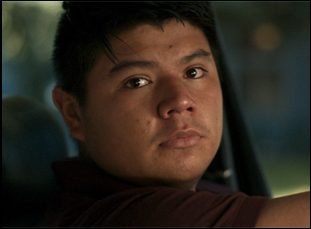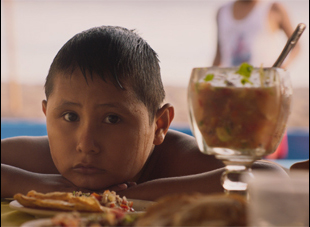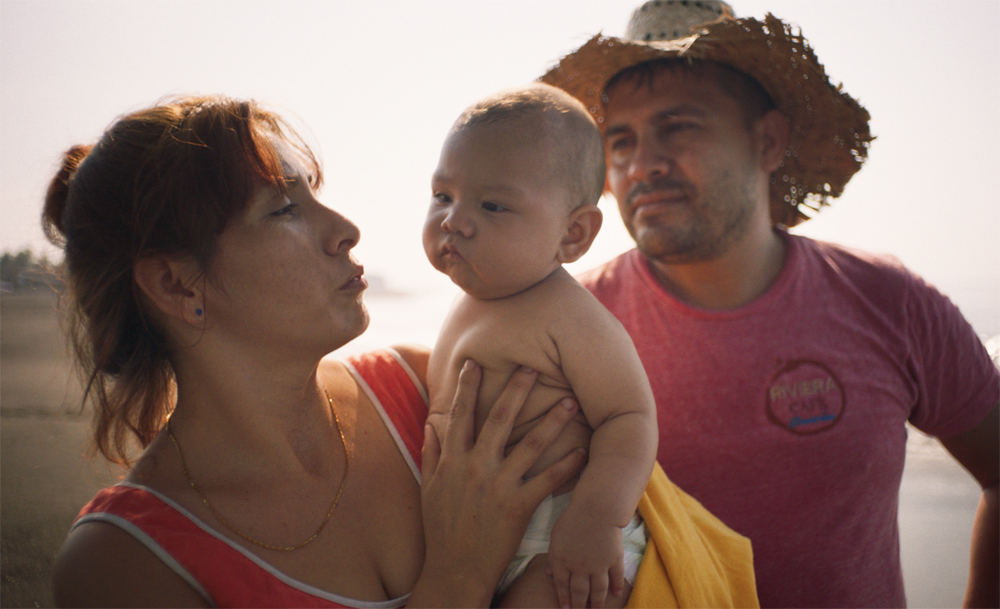In his work to support himself as a boundary-pushing filmmaker, Rodrigo Reyes had seen plenty of court cases as a Spanish interpreter, but none had left such an impression on him as the one involving Sansón Noe Andrade, who at 19 seemed impossibly young to be locked away with no obvious path back into society after being convicted as an accomplice to murder, having been in the driver’s seat when his brother-in-law killed a member of a rival gang. Reyes knew there had to be more to the story than what he had heard from the evidence — not necessarily the crime which Andrade had taken responsibility for his part in, but how he ended up in such a position, trying to acclimate to a culture he hadn’t grown up around in California after he was born in the Mexican city of Tecomán and brought across the border to live with his aunt at the age of 12. Reyes didn’t think his professional lives would cross, but the producer Su Kim, who had worked with him on his previous film “499,” as well as films such as “Midnight Traveler” and “Hale County This Morning, This Evening,” suggested he write to Andrade when he might be thinking of Reyes, one of the last people to help him on the outside as a translator, as well.
It was the right instinct when Andrade and Reyes would strike up an ongoing dialogue as the former continues to serve out his sentence that becomes the basis for “Sansón and Me,” an act of compassion as much as it is a compelling documentary when Reyes turns the impossibility of recording their conversations on camera when he was prevented by the penal system from doing so into a lifeline in a variety of ways for Andrade, who gets to share his side of the story and allows his family back in Tecomán to understand what’s become of him when communication with them is otherwise difficult. Over the better part of a decade, Reyes arranged for Andrade’s sister Debora and his nephew Tonito to be involved in recreations of the life he had before leaving for the States. While it’s the only way for Reyes to illustrate Andrade’s upbringing — though his way with words in letters he pens to the director are as vivid as any image could be — the recreated scenes allow for a connection between the family that might otherwise be thought lost forever, reexamining their own history living barely above the poverty line and touch on concerns that Tonito may be doomed to a fate similar to Sansón when the community seems trapped in a vicious cycle of wealth disparity in the region.
Andrade is aware from the start that the film won’t change the direction of his life, but it will reflect it in a way that is bound to change perception of who he is and so many other immigrants like him who find their way to another country by circumstances well out of their control and struggle to acclimate and as Reyes finds himself relating to him in ways he might not have expected at first, “Sansón and Me” resonates just as powerfully amongst anyone who comes into contact with it. After making its premiere at last year’s Tribeca Film Festival, the film is arriving in theaters this week and Reyes spoke to the impact the film has already had on himself and Andrade, who has yet to see it, and how it wasn’t difficult to bring out the poetry that lives inside him.

I get that question a lot — what was it about this one case? We live in a culture where we are saturated with stories of crime and courts and we look to this space for drama and tension and all of this excitement. And when people look at Sansón’s story on the surface, there’s this question of what’s the real story here? Not a whodunit — it’s not a wrongful conviction, per se. It’s much more complex than that. It’s more nuanced. So for me, jumping into it, really it was about that spark of connection, looking at him and wanting to know who are you and what got you here? What’s your life story? How did you end up in this situation? All these unanswered questions drove me to make this film.
Once he responded and said, “Hey, I wanna get to know you,” that’s when I was hooked because we had a connection and a friendship started to bloom. Now in hindsight, after 10 years, it’s really interesting what happens when we’re willing to look at the messiness and the grayness of things. We complain about violence and other problems that we have in our society, but we don’t want to look because when you look, it gets really messy, but it’s also really beautiful. I think Sansón demonstrates that — there’s so much potential in his story. There’s so many more questions about things that could be done differently. So it was a little spark that just started setting off a bunch of chain reactions and it became a whole universe for me.
In the decade you were working on this, you actually made other films that were nonfiction/narrative hybrids and I wondered whether when you realized you couldn’t tell this story without dipping into narrative elements, did it actually influence how you made the other films or did making the other films prepare you for this?
I kept trying to find a way to tell Sansón’s story, and not just to tell his story, but to find the language to share his spirit, that essence that I saw when I was visiting him and I was reading his letters, so we tried all these different ways. What was really lucky in a way was having this challenge of no access — no interview, no archival, no news coverage — because it pushed the film to find other ways of expressing itself. And along the way, I made other works like “499,” [which] was very instructive to me because with that film, I learned how to find a balance between the scripting of a story and responding to the reality of a story. Then I also worked with the same team — the same cinematographer and the same editors, so they all knew about Sansón too, which is probably very confusing and crazy for them as well, but it was a detour that brought us back into “Sansón” with more tools and just more growth
So often we’re making films and we like to pretend like it’s hatched out of us in this complete way, and the reality is that it’s a struggle. “Sansón” was very much that journey of trial and error and just getting to that place where I felt I was seeing my friend in the film where I felt like his essence was there. Because it’s not just what he’s saying, it’s how he says it and the poetry of his voice. Another milestone was working with the family. When the family agreed from the interview and the conversation phase into being an active collaborator in his storytelling, that was dynamite, but it took a while to process. I always think of films as having three life cycles — the idea, the production, and the edit — and it’s almost like the hero’s journey [where] the film has to like be reborn in each one of those. It has to go through all these struggles and then come back, and “Sansón” did that. It kept getting reworked in each stage, and I feel really lucky that it went that way and it wasn’t easy. It made the film very special and it really got us as close as possible to his spirit.
When you involve the family or any real life subjects that replay their lives to some degree, are there things that are revealed in that process that you or even they may not have expected?
Yeah, a revealing anecdote was we had a special screening in San Francisco [where] the SF Film Festival does a series called Doc Stories. It was a rainy day, but luckily the theater was packed and there were a ton of people there, and I’m standing there saying hello, and then I look around and I notice this Mexican family — a mother and son, and he’s in his twenties and she’s like in her fifties, and they seem a little out of place. They don’t seem like folks who habitually go to film festivals, they seem more like working class migrants. And it turns out that they were Sansón’s family members who had found me on the internet and they lived far away from the Bay and drove in early in the morning to come and watch this film and [Sansón] is a family member that they haven’t talked to in decades. Hearing from them about the film, the key thing I remember was that they felt they had ignored his needs and his struggles and that they had been telling themselves a story of who this kid was. It was very different from what he felt. [So it was] that moment of [them realizing] “Wow, this is what you went through.”
That’s why the family had to be involved in this film because we tell ourselves stories and those stories frame how we see the world and Sansón hasn’t had a chance to say, “Hey, I lived it this way. I needed this or I went through that.” That revelation is really powerful. Now, Sansón and his aunt and nephew are in touch after 15 years and that’s part of the power of that collaboration — to step into his shoes and to really not just see what he went through, but then also understand he’s trying to say something to move us forward as a family. So for me, his generosity is just so nourishing because by participating in this film, he’s also opening opportunities to the future. It’s not just about the past. As you walk away from the movie, you have to think, “Well, what do I do now with the story?” [Which is] very wise of him. Sansón is just so smart and so full of wisdom, and as the film is rolling out into the world and you see the ripple effects it’s having, it’s provoking so much thinking and reflection.
You said something in another interview about how you envisioned the film as a ballad. How did that give shape to how best to present this story?
Yeah, in Mexico, we have a long tradition of ballads that narrate real life, often crime or just someone’s story, and there was something about the way he told his life to me that was very much like these corridos because there’s poetry to them. They’re very, they’re very discreet and very intense, but they also linger. They build images in your head, and in the actual film, there’s a song that you keep hearing on the radio that Sansón wrote as a poem and we set it to music with this amazing band from Mexico City. It makes so much sense because he is telling a ballad, making his circumstance epic. There’s something really wonderful about that and I think the song is really good and it captures that essence of how he sees his life in this very epic scope, so that was very inspiring to me.
I didn’t want the film to feel like we were coming in from the outside and imposing a language that was more intellectual or more sophisticated. I want it to be very organic. That’s another reason why the family [having an on-screen role] was important, because you can tell when you see an actor and the film is asking you to suspend disbelief to believe this actor, but it’s very different when you know, “Oh wow, this is someone that’s related to him. And these are the streets where he was, walking and living and having adventures and going through tragedy.” It just heightens the intensity of the film and it cuts so deep like these ballads.

When Sansón starts to relate to me, “Hey man, I didn’t expect this to be painful for me and my family,” we left that in the film because I think very often we don’t ask that question of what is the actual toll or the effects of telling this story and remembering what we’ve gone through— this trauma, bringing it back — what does it mean and how does it feel? That doesn’t mean that we should avoid painful stories and I don’t think at all that’s what Sansón was saying. He just wanted to be recognized and to be heard and for me to understand that it’s not just a movie, there’s a deeper process to it. That was a big learning moment for me. And I think now that the film is going out to theaters and seen widely, I want to remember that always — there’s a real person here.
So I go to screenings now and I show up with a handful of postcards that I’ve self-addressed to him [with] postage on them. Why? Because it’s not just a movie. If you wanna reach out to the real person, you can, and you could send a message and you could show a little support or ask a question or make a comment, whatever that transcends just the needs of just this film because it’s not just a piece of cinema. It’s not just entertainment. It’s so much more. There’s a young man there who’s still fighting his case, who’s still hoping to be free and people [who see the film] feel really excited about that because it shifts the focus. All of a sudden, it’s something deeper and more real than just going and watching a film, which is great, but [Sansón] taught me not to forget there’s somebody’s very real behind it all.
I wouldn’t want you to speak for him, but do you know what it’s been like for Sansón to receive messages as the film is out there in the world and he has yet to see it?
It’s pretty bizarre when he’s getting postcards from all over the place and he hasn’t seen the movie, so he’s he’s doing it all completely backwards, right? [laughs] Eventually in September when it’s broadcast on PBS on Independent Lens, he’s going to see it and his friends inside are going to see it and be able to respond to it, but right now he’s living in this surreal space where people are responding to something very intimate to him that he has not been able to witness. He’s been able to talk to people he trusts — his family, to his nephews, to his uncle, to his sister — so he can gauge the impact of the film beyond me telling him like, “Hey, this is what it’s done and it’s all great,” so he can he can try to be a little more objective, but it must be just totally crazy to be in a film that’s completely about [him] that’s so deep and then not be able to see it. But he’s a trouper and he’s been really patient with it and I think he’s very, very excited to finally get to watch it.
“Sansón and Me” opens on March 3rd at the BAMCinematek in Brooklyn, March 17th in San Francisco at the Roxie Theater, March 20th and 21st in Los Angeles at the Monica Film Center, the Claremont 5 and the Laemmle Glendale, and March 22nd in Memphis at Indie Memphis.




